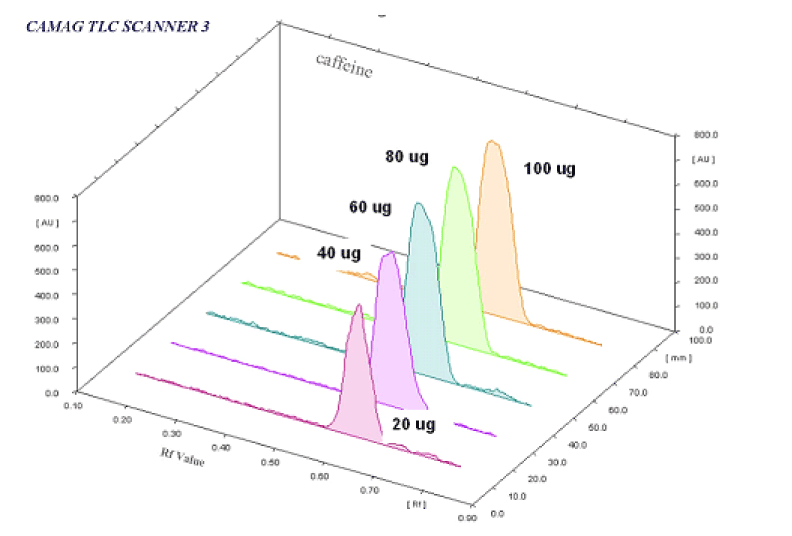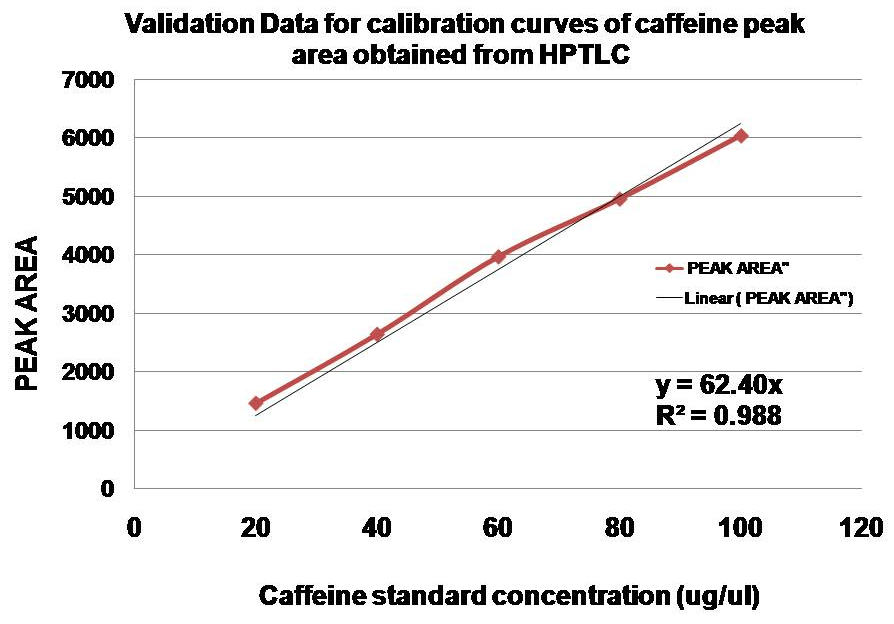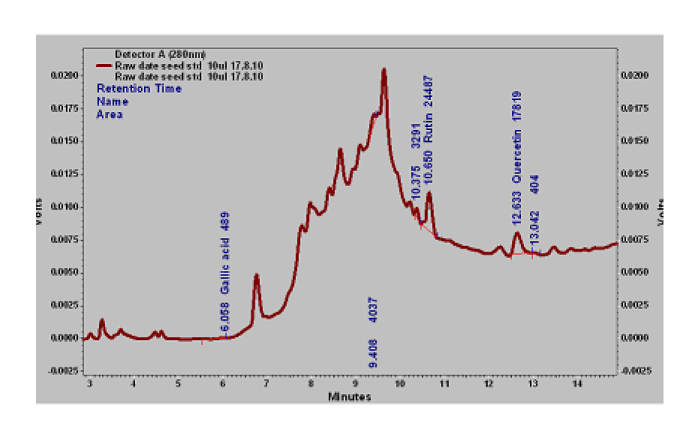| Research Article |
Open Access |
|
| R. Paranthaman* Praveen Kumar. P and S. Kumaravel |
| Ministry of Food Processing Industries, Indian Institute of Crop Processing Technology, Thanjavur-613 005, Tamilnadu, India |
| *Corresponding authors: |
R. Paranthaman
Ministry of Food Processing Industries
Indian Institute of Crop Processing Technology
Thanjavur-613 005, Tamilnadu, India
Tel: 04362226676
E-mail: paranthhu@gmail.com |
|
| |
| Received February 03, 2012; Published August 24, 2012 |
| |
| Citation: Paranthaman R, Praveen Kumar P, Kumaravel S(2012) HPLC and HPTLC Determination of Caffeine in Raw and Roasted Date Seeds (Phoenix Dactylifera L). 1: 249. doi:10.4172/scientificreports.249 |
| |
| Copyright: © 2012 Paranthaman R, et al. This is an open-access article distributed under the terms of the Creative Commons Attribution License, which permits unrestricted use, distribution, and reproduction in any medium, provided the original author and source are credited. |
| |
| Abstract |
| |
| Caffeine-containing products have been consumed for hundreds of years for their pleasant flavor and stimulating effects. In recent years, caffeine received increasing attention in food and pharmaceutical industries, due to its pharmacological properties which comprise stimulation of the central nervous system, peripheral vasoconstriction, relaxation of the smooth muscle and myocardial stimulation. The aim of this study was to determine the content of caffeine in raw and roasted date seeds. The caffeine content was determined by HPTLC-UV densitometric analysis. The highest caffeine content in the roasted date seed was determined by employing the HPTLC analysis (34.72 mg/ gm). The content of the flavonoids of raw date seeds and roasted date seeds were determined using HPLC methods. The highest content of flavonoids was determined in roasted date seeds gallic acid (0.1mg/gm), Rutin (2.2mg/gm), and Quercetin (0.52 mg/gm and raw date seeds contains gallic acid (0.1mg/gm), Rutin (0.4mg/gm), and Quercetin (0.9mg/gm). |
| |
| Keywords |
| |
| Date seed; Caffeine; HPTLC; HPLC; Flavonoids |
| |
| Introduction |
| |
| Caffeine, 1,3,7-trimethylxanthine, is the major alkaloid ingredient in about 60 herbs, including Thea sinensis (tea leaves), Coffea arabica (coffee beans), Theobroma cacao, Paulinea coppana (guarana seeds) and Cola nitida (kola nuts), to which their CNS stimulant is attributed [1]. The pharmacological effect of caffeine can be achieved when it is consumed in the form of herbal extract or pure ingredient added to various food products. Hot tea and coffee drinks are among the most popular sources for obtaining the desired effect of caffeine, providing ca. 50 and 100 mg caffeine per cup, respectively [2]. Caffeine is also a common ingredient in many painkillers and antimigraine pharmaceuticals. With the recent reemergence of medicinal herbs as a major player in the global dietary supplement market, such new products containing caffeine have been introduced. The levels of caffeine in different matrices (e.g. biological, pharmaceutical and herbal) have been determined by numerous techniques, including spectroscopic and chromatographic methods [3-8]. High Performance Thin Layer Chromatography (HPTLC), coupled with densitometric detection, is among the various methods reported for the quality control of pharmaceutical products containing caffeine [9]. As such, HPTLC may be utilized as an effective analytical tool for the quality control of caffeine-containing dietary supplements. In this report, a developed HPTLC method was validated for specificity, linearity of calibration, recovery, accuracy and precision (repeatability) and was used to determine the levels of caffeine in stimulant herbal products and power drinks on the Saudi market. |
| |
| Dates (Phoenix dactylifera L.) have always been a valuable crop inarid and semiarid parts of the world and play an important role in the economic and social lives of the people of the sezones [10]. The seed powder is best medicine for Diabetic patients. The seed powder is an ingredient in a paste given to relieve ague. Date seeds are discarded or used mainly as animal feeds for cattle, sheep, camel and poultry [11]. An additional function includes roasting the date pits and making a caffeine-free drink which can substitute coffee when caffeine is a concern but a coffee-related flavor. |
| |
| The aim of this study was to compare raw and roasted date seeds for determination of caffeine content by using High Performance Thin Layer Chromatography (HPTLC) method and flavonoids quantification by High Performance Liquid Chromatography (HPLC). Results of this study could be used to facilitate selection of the appropriate method in order to obtain satisfactory data on caffeine content in plant materials. |
| |
| Materials and Methods |
| |
| Samples |
| |
| The investigation was performed on dried seeds of the Date fruit seeds and were collected from the local market of Thanjavur, Tamilnadu. The date seeds were free of physical damage and injury from insects and fungal infection, were selected and used for all experiments. The experiment consisted of two treatments with four replication in a Randomized Block Design. |
| |
| Chemicals |
| |
| All chemicals and solvents were obtained from Sigma–Aldrich Co. Ltd. (India) & E Merck. |
| |
| Seed samples and processing |
| |
| The matured seeds of Phoenix dactylifera L. were purchased from market located at Thanjavur, TamilNadu. The seeds (150 g) were dry heated along with acid washed sea sand on an open hot plate at 125 ± 2ºC for 25 min [12]. During the heat processing frequent (every 3 min) clarification of seeds together with the sand was done using a glass rod for uniform heating. The seeds were separated by sieving and cleaned thoroughly. The Raw date seeds and dry heated (Roasted) seed samples were ground to a fine powder and stored in a separate screw cap bottle at 20°C before analysis. |
| |
| Determination of caffeine content by HPTLC method |
| |
| Standard solutions: A solution of caffeine standard was prepared by dissolving 2 mg accurately weighed, in 5 mL methanol (Merck, Germany) in a volumetric flask. This is the stock solution. It was further diluted for preparing six points calibration curves. |
| |
| Sample preparation: One gram of the finely dried seed powdered of plant material was extracted two times with 25 mL of methanol on a water bath at 70ºC for 20 min. Each of the extracts from the same samples were combined, partially evaporated and concentrated to dryness under vacuum. After that the extracts were re-dissolved in methanol. Prior to use, all the samples were filtered through 0.45μm filter. |
| |
| High performance thin layer chromatography: A Camag HPTLC system equipped with an automatic TLC sampler, TLC scanner 3 and integrated software WINCATS version 1.4.1 was used for the analysis. Chromatrography was performed on 10 cm × 10 cm HPTLC plates coated with silica gel 60F254 (E.Merck) of 200 μm layer thickness for the quantification of caffeic acid.. Standard and samples were applied to the plates as 8mm long bands, 8mm apart by use of a Camag Linomat (V) sample applicator equipped with a 100 μl microsyringe and an automatic TLC sampler under a flow of Nitrogen gas. |
| |
| Detection and estimation of caffeine: The linear ascending development was carried out in a Camag glass twin through chamber (20 cm × 10 cm) previously saturated with 20 mL mobile phase with ethyl acetate-acetic acid-formic acid-water (100:11:11:27, v/v/v/v) for 15 min at room temperature 25ºC. Plates were developed to a distance of 80 mm [13]. Subsequent to the development; the TLC plate was dried in a current of air with an air dryer. After development, plates were dried and derivatised in NP-PEG reagent. Quantitative evaluation of the plate was performed in absorbance-reflectance mode at λmax = 326 nm, using a slit width 6 × 0.4 mm, data resolution 100 mm Step - 1, scanning speed 20 mm s-1 and baseline correction was used. |
| |
| Validation of the method: |
| |
| Linearity: Standard solutions (2 mg/5 mL) were prepared. Chromatograms were developed after application of 20, 40, 80, 160, 240 and 360 μg mL-1 of these working solutions. A six-point calibration was obtained for each analyte by fitting peak areas to the amount (μg) of the compounds by least squares regressions (Figure 1, Table 1). The correlation coefficient was found to be 0.988 (Figure 2, Table 2). |
| |
|
|
Figure 1:HPTLC chromatogram of caffeine standard in different concentrations. |
|
| |
|
|
Figure 2:Validation Data for Calibration curves of caffeine peak area obtained from HPTLC. |
|
| |
|
|
Table 1: Validation data of caffeine standards obtained from HPTLC chromatogram. |
|
| |
|
|
Table 2: Linear regression data for calibration curves of caffeine peak area obtained from HPTLC. |
|
| |
| HPLC analysis of flavonoids |
| |
| Standard preparation: Standard stock solution of gallic acid, Rutin & Quercetrin (Sigma) was prepared in methanol, at concentrations of 5mg/ml. Standard solution were filtered through 0.45 mm membrane filter and injected by autosampler. |
| |
| Sample preparation: 2 g of powdered raw date seed and fried date seed powders were extracted with 50 mL of 95% ethanol under 80 KHz, 45° C in ultrasonic extraction device for 30 min, repeated twice. The extract was collected and filtered; the filtrate was dried at 50°C under reduced pressure in a rotary evaporator. The dried crude extract was dissolved in the 100 mL mobile phase. After filtering through a filter paper and a 0.45 um membrane filter (Millipore), the extract was injected into HPLC [14]. |
| |
| HPLC conditions: Flavonoids were analysed using a Shimadzu HPLC system (Shimadzu Corp., Kyoto, Japan) consisting of a LC-10AD pump, SCL 10A system controller and SPD-M 10A UV detector. The gradient elution of solvent A [water-acetic acid (25:1 v/v)] and solvent B (methanol) had a significant effect on the resolution of compounds. As a result, solvent gradients were formed, using dual pumping system, by varying the proportion of solvent. A [water-acetic acid (25:1, v/v)] to solvent B (methanol). Solvent B was increased to 50% in 4 min and subsequently increased to 80% in 10 min at a flow rate of 1.0 mL/min. Detection wavelength was 280 nm. |
| |
| Results and Discussions |
| |
| HPTLC determination of caffeine in date seed |
| |
| Experimental conditions were optimized for separation the Rf value of caffeine was 0.68 and the compound was well resolved from other components of the extract. The extract of raw and fried date seeds, when subjected to HPTLC, showed the presence of caffeine in all the samples. Comparison of the peak for the standard of caffeine revealed the identity of caffeine present in the samples . Validation of the method showed the linear range of 20-100 μg mL-1 for caffeine. More accumulation of caffeine in fried date seeds than other raw date seed [15-17] and data presented in Table 3 and Figure 3. |
| |
|
|
Figure 3:HPTLC Chromatogram of caffeine in Date seed samples. |
|
| |
|
|
Table 3: Validation data for analysis of caffeine in Date seed samples. |
|
| |
| HPLC determination of flavonoids in date seed |
| |
| |
| RP-HPLC analysis is the most used method for the identification of plant phenolic compounds. The HPLC Result shows based on the flavonoids standards Retention time (Rt), Gallic acid (Rt-5.558), Rutin (Rt-10.525) and Quercetin (Rt-12.408) in Table 4 and Figure 4. The flavonoids content in Raw date seeds was found to be Gallic acid (0.1 mg/gm), Rutin (0.4 mg/gm), and Quercetin (0.9 mg/gm) shown in Table 5 and Figure 5. The obtained value was compared with standard. The flavonoids content in Roasted date seeds was found to be Gallic acid (0.1 mg/gm), Rutin (2.2 mg/gm), and Quercetin (0.52 mg/gm) shown in Table 6 and Figure 6. The obtained value was compared with standard. Although there have been papers evaluating the impact of roasting on the polyphenolic compounds and antioxidant capacity date seed, there is no paper evaluating the influence of roasting conditions on caffeine content. By knowing the exact impact of roasting on the bioactive compounds of date seed and conducted in a way to achieve the desired (increased or decreased) content of bioactive compounds [18]. Due to the beneficial potential of caffeine and polyphenolic compounds, roasting is recommended for Date seed processing. |
| |
|
|
Figure 4:HPLC chromatogram of flavonoids standard. |
|
| |
|
|
Figure 5:HPLC chromatogram of raw date seed. |
|
| |
|
|
Figure 6:HPLC chromatogram of Roasted Date seed. |
|
| |
|
|
Table 4: Validation data for flavonoids standard. |
|
| |
|
|
Table 5: HPLC validation data for Raw date seed. |
|
| |
|
|
Table 6: HPLC validation data for Roasted date seed. |
|
| |
| Conclusion |
| |
| The results obtained in this study provide a detailed overview of the effect of roasting on the content of caffeine. The results revealed that the content of caffeine and flavonoids on the raw and roasted date seeds and are affected by the roasting conditions. Roasted date seeds exhibited the highest overall content of caffeine and flavonoids and antioxidant capacity than raw date seed. Caffeine is a pharmacological active substance and depending on the dose, can be a mild central nervous system stimulant. |
| |
| Acknowledgements |
| |
| The authors deeply thanks the Dr. K. Alagusundaram, Director, Indian Institute of Crop Processing Technology, Ministry of Food Processing Industries, Government of India, Thanjavur for Providing all the facilities and support used to carry out the work. |
| |
| |
| References |
| |
- Bruneton J (1999) Pharmacognosy, phytochemistry, medicinal plants. Technique & Documentation Lavoisier, Paris, France.
- International Food Information Council Foundation (1998) Caffeine & Health: Clarifying The Controversies. Washington, DC.
- Dinc E, Baleanu D (2002) Two new spectrophotometric approaches to the multicomponent analysis of the acetaminophen and caffeine in tablets by classical least-squares and principal component regression techniques. Il Farmaco 57: 33-37.
- Ferreyra CF, Ortiz CS (2002) Simultaneous spectrophotometric determination of phenilpropanolamine HCL, caffeine and diazepam in tablets. J Pharm Biomed Anal 29: 811-818.
- Liang Y, Lu J, Zhang L, Wu S, Wu Y (2003) Estimation of black tea quality by analysis of chemical composition and colour difference of tea infusions. Food Chem 80: 283-290.
- Song S, Ashley DL (1998) Supercritical fluid extraction and gas chromatography/mass spectrometry for the analysis of tobacco-specific nitrosamines in cigarettes. Anal Chem 71: 1303-1308.
- Yao L, Jiang Y, Datta N, Singanusong R, Liu X, et al. (2004) HPLC analyses of flavanols and phenolic acids in the fresh young shoots of tea (Camellia sinensis) grown in Australia. Food Chem 84: 253-263.
- Zuo Y, Chen H, Deng Y (2002) Simultaneous determination of catechins, caffeine and gallic acids in green, Oolong, black and pu-erh teas using HPLC with a photodiode array detector. Talanta 57: 307-316.
- Bebawy LI, El-Kousy NM (1999) Simultaneous determination of some multicomponent dosage forms by quantitative thin layer chromatography densitometric method. J Pharm Biomed Anal 20: 663-670.
- Besbes S, Blecker C, Deroanne C, Drira NE, Attia H (2004) Date seeds: chemical composition and characteristic profiles of the lipid fraction. Food Chem 84: 577-584.
- Rahman MS, Kasapis S, Al-Kharusi NSZ, Al-Marhubi IM, Khan AJ (2007) Composition characterization and thermal transition of date pits powders. J Food Eng 80: 1-10.
- Siddhuraju P (2006) The antioxidant activity and free radical-scavenging capacity of phenolics of raw and dry heated moth bean (Vigna aconitifolia) (Jacq.) Marechal seed extracts. Food Chem 99: 149-157.
- Armatu A, Colceru-mihul S, Bubueanu C, Draghici E, Pirvu L (2010) Evaluation of antioxidant and free scavenging potential of some Lamiaceae species growing in Romania.Rom Biotechnol Lett 15: 1-7.
- Samee W, Vorarat S (2007)Simultaneous Determination of Gallic acid, Catechin, Rutin,Ellagic Acid and Quercetin in Flower Extracts of Michelia alba, Caesalpinia pulcherrima and Nelumbo nuciferaby HPLC. Thai Pharm Health Sci J 2: 131-137.
- del Castillo MD, Gordon MH, Ames JM (2005) Peroxyl radical-scavenging activity of coffee brews. European Food Research and Technology 221: 471-477.
- Nicoli MC, Anese M, Manzocco L, & Lerici CR (1997) Antioxidant properties of coffee brews in relation to the roasting degree. LWT – Food Science and Technology 30: 292-297.
- Stalmach, A., Mullen, W., Nagai, C., & Crozier, A., 2006. On-line HPLC analysis of the antioxidant activity of phenolic compounds in brewed, paper-filtered coffee. Braz J Plant Physiol 18: 253-262.
- Hecimovic I, Belscak-Cvitanovic A, Horzic D, Komes D (2011) Comparative study of polyphenols and caffeine in different coffee varieties affected by the degree of roasting. Food Chem 129: 991-1000.
|
| |
| |






